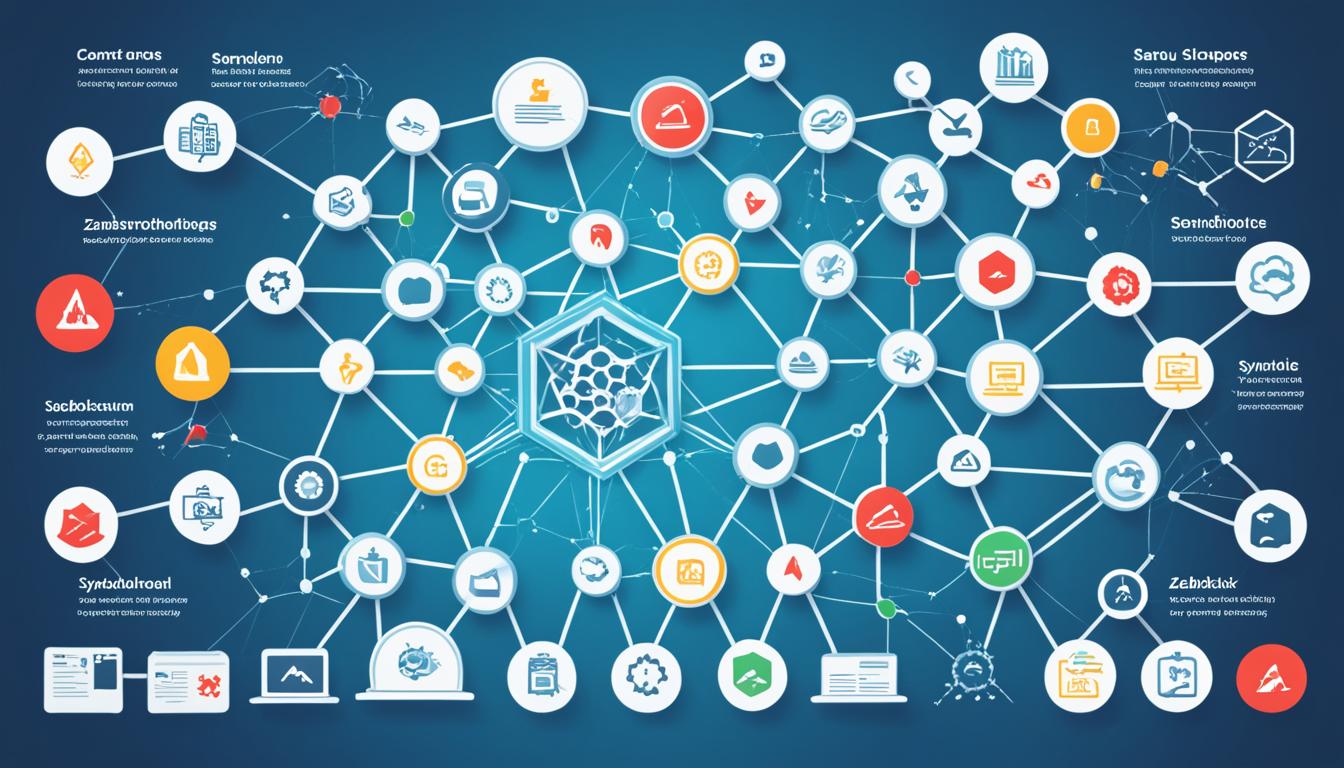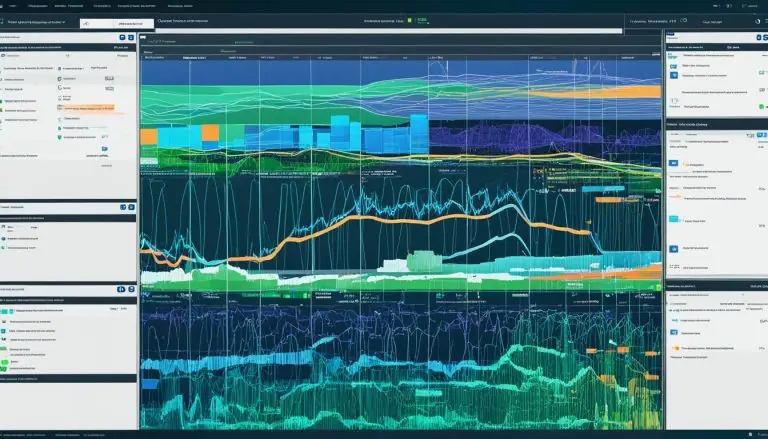Zabbix vs. Sensu: Which Monitoring Tool Wins?
When it comes to network monitoring tools, open-source options provide flexibility and cost-effectiveness. Two popular choices in this space are Zabbix and Sensu. But which one comes out on top in a head-to-head comparison? In this article, I’ll delve into the features, performance, scalability, and alerting capabilities of Zabbix and Sensu, helping you make an informed decision for your monitoring needs.
Key Takeaways:
- Zabbix and Sensu are both open-source monitoring tools for network infrastructure
- Both tools offer a range of features, including performance monitoring, alerting, and scalability
- Zabbix is known for its agent-based architecture and comprehensive data visualization capabilities
- Sensu specializes in cloud monitoring, automation, and compatibility with existing plugins and instrumentation
- Consider your specific monitoring requirements and infrastructure before choosing between Zabbix and Sensu
Sensu Advantages
Sensu offers several unique advantages as a monitoring tool. Its features and capabilities make it an ideal choice for modern IT environments. Here are some key advantages of using Sensu:
- Cloud Monitoring: Sensu is designed specifically for cloud environments, allowing organizations to effectively monitor their cloud infrastructure. It automatically registers and deregisters endpoints to accommodate dynamic changes in the infrastructure, ensuring accurate monitoring and alerting.
- Monitoring Automation: Sensu embraces monitoring automation, enabling organizations to treat configuration changes as code. This approach simplifies and streamlines the management and deployment of monitoring configurations, making it easier to maintain and scale the monitoring system.
- Plugin Compatibility: Sensu provides seamless compatibility with existing monitoring plugins and instrumentation. This allows businesses to leverage their existing investments in monitoring tools and easily integrate them with Sensu, without disruption or additional configuration.
- Business Continuity: Sensu offers business continuity for legacy infrastructure and multi-cloud environments. It ensures that monitoring is consistently available even during infrastructure changes or failures, safeguarding crucial business operations.
- Container Monitoring: Sensu supports container monitoring, including popular container orchestration platforms like Kubernetes. This enables organizations to monitor the health and performance of their containerized applications and infrastructure, ensuring optimal operation and resource utilization.
- Monitoring-as-Code: Sensu enables monitoring configurations to be defined and managed as code. This approach, known as monitoring-as-code, allows for version control, automated deployment, and easier collaboration among teams, promoting efficiency and accuracy in monitoring management.
- Integration: Sensu seamlessly integrates with various best-of-breed products and tools, enhancing its capabilities and extending its functionality. This integration allows organizations to leverage their existing technology stack and take advantage of a comprehensive monitoring solution tailored to their specific needs.
- IoT Monitoring: Sensu’s flexible architecture and plugin framework make it suitable for monitoring Internet of Things (IoT) devices and environments. It provides organizations with the ability to monitor, gather data, and analyze the performance and health of IoT devices, ensuring optimal operation and security.
- Security: Sensu prioritizes enterprise-grade security to protect monitoring data, configurations, and sensitive information. It offers robust security features and controls, ensuring that monitoring activities are conducted in a secure and compliant manner.
- Scalability: Sensu provides unlimited scalability, allowing organizations to monitor thousands or even millions of endpoints without compromising performance. Its architecture and design enable efficient and effective monitoring at any scale, supporting the growth and evolution of IT infrastructures.
With its cloud monitoring capabilities, monitoring automation features, plugin compatibility, business continuity support, container monitoring functionality, monitoring-as-code approach, integration options, IoT monitoring capabilities, security measures, and scalability, Sensu stands out as a versatile and powerful monitoring tool for modern IT environments.
Zabbix Advantages
When it comes to monitoring IT infrastructure, Zabbix offers a variety of advantages that make it a popular choice among users. With its comprehensive monitoring capabilities and agent-based architecture, Zabbix excels at data collection for effective monitoring.
One of the key advantages of Zabbix is its scalability. It allows users to monitor a large number of nodes from a single cluster, making it suitable for organizations with complex and extensive infrastructures.
Zabbix also provides robust data visualization and dashboard creation features, allowing users to easily gather insights and analyze monitoring data. The customizable dashboards help visualize important metrics and trends, enabling users to make informed decisions.
In addition to visualization, Zabbix is equipped with efficient alerting and incident management capabilities. It notifies users promptly when issues occur, allowing for quick response and resolution. Zabbix’s alerting system can be customized to meet specific needs and preferences, ensuring that no critical event goes unnoticed.
Another advantage of Zabbix is its auto-discovery feature, which automatically detects and adds new endpoints to the monitoring system. This saves time and effort by eliminating the need for manual configuration whenever new devices or services are added to the infrastructure.
Zabbix’s extensibility is yet another notable advantage. With the ability to create custom scripts and integrations, users can extend the functionality of Zabbix to suit their specific requirements. This flexibility allows for tailored monitoring solutions that cater to unique use cases.
Furthermore, Zabbix benefits from a vibrant community and extensive support. Users can turn to the active Zabbix community for assistance, guidance, and sharing best practices. The community-driven development ensures continuous improvements and updates to the tool.
To summarize, Zabbix offers various advantages, including its comprehensive monitoring capabilities, agent-based architecture, scalability, visualization features, robust alerting and incident management, auto-discovery functionality, extensibility through custom scripts, and strong community support.
Functionality Overview
When comparing monitoring tools like Zabbix and Sensu, it is important to have a clear understanding of the functionality offered by each tool. This section will provide an overview of the key features and capabilities of both Zabbix and Sensu, allowing you to make an informed decision based on their metrics collection, data visualization, incident management, scalability, compatibility, and alerting capabilities.
Zabbix Features
Zabbix is a comprehensive monitoring solution that offers a wide range of features to monitor your IT infrastructure. It provides robust metrics collection, allowing you to gather data from various sources to gain insights into the performance and health of your systems. Zabbix also offers powerful data visualization tools, enabling you to create custom dashboards and charts to analyze and visualize your monitoring data.
In terms of incident management, Zabbix provides alerting capabilities that allow you to set up notifications for critical issues and incidents. Its scalability allows you to monitor a large number of nodes, making it suitable for environments with complex and distributed infrastructures. Furthermore, Zabbix is compatible with different platforms and operating systems, ensuring seamless integration with your existing IT ecosystem.
Sensu Features
Sensu is an open-source monitoring tool that provides a range of features designed to monitor modern infrastructure and applications. It offers metrics collection capabilities that enable you to collect and analyze data from various sources, allowing you to gain deep insights into the performance of your systems.
When it comes to data visualization, Sensu allows you to create custom dashboards and visualizations to help you understand and analyze your monitoring data. Incident management is another key feature of Sensu, with advanced alerting capabilities that enable you to receive timely notifications and take immediate action when critical issues occur.
Sensu is highly scalable, allowing you to monitor large and complex environments with ease. It is also compatible with different platforms and provides seamless integration with existing tools and solutions. This makes Sensu a flexible and adaptable monitoring tool for diverse IT environments.
In conclusion, both Zabbix and Sensu offer a wide range of functionality to meet the monitoring needs of modern IT infrastructures. It is essential to carefully consider the specific requirements and challenges of your environment when choosing between these two tools. Whether you prioritize metrics collection, data visualization, incident management, scalability, compatibility, or alerting capabilities, both Zabbix and Sensu provide powerful solutions to help you monitor and manage your IT infrastructure effectively.
Installation and Deployment
When it comes to choosing a monitoring tool, installation and deployment are crucial considerations. Both Zabbix and Sensu provide installation guides, but the ease of use can vary. On the other hand, Prometheus offers a straightforward installation process. Let’s compare the installation experiences of these tools to determine their user-friendliness and ease of deployment.
Zabbix Installation
Zabbix offers comprehensive installation guides that walk you through the process step by step, making it accessible even for beginners. The guides provide detailed instructions and cover various deployment scenarios, ensuring that you can set up Zabbix according to your specific requirements.
Sensu Installation
Similar to Zabbix, Sensu provides installation guides that cater to different environments and use cases. These guides simplify the deployment process and help you get Sensu up and running quickly. With Sensu’s clear documentation, you can navigate through the installation process with ease and confidence.
Prometheus Installation
Prometheus stands out for its simplicity and ease of installation. With straightforward installation steps, Prometheus makes it easy for both beginners and experienced users to get started quickly. Its user-friendly approach ensures a smooth deployment process without compromising on functionality.
In summary, Zabbix, Sensu, and Prometheus offer different experiences when it comes to installation and deployment. While Zabbix and Sensu provide comprehensive installation guides that cater to various scenarios, Prometheus shines with its simplicity and ease of use. Ultimately, the choice depends on your specific requirements and preferences. Take the time to explore the installation guides for each tool to determine which one aligns best with your needs.
Metrics Collection
Metrics collection is a fundamental aspect of any effective monitoring tool. In the context of Zabbix, Sensu, and Nagios, these tools offer different approaches to handle data collection, ensuring comprehensive insights into the IT infrastructure.
Let’s start by examining Zabbix’s metrics collection capabilities. Zabbix provides a wide range of data collection methods, allowing users to monitor various aspects of their IT environment efficiently. The tool supports agent-based data collection, where agents are installed on target machines to collect specific metrics. This approach enables detailed monitoring and the retrieval of key performance indicators (KPIs) for different system components. Zabbix offers a rich library of built-in metrics, covering network performance, server health, and application monitoring. Additionally, users can leverage plugins to further customize the metrics collection process and extract specific data points relevant to their environment. This plugin compatibility enhances Zabbix’s flexibility and adaptability.
On the other hand, Sensu also emphasizes comprehensive metrics collection. Sensu uses the Sensu Agent, a lightweight software package installed on endpoints to collect and send metrics to the central Sensu backend. The Sensu Agent supports a variety of data collection methods, including system-specific collectors for CPU, memory, disk, and network metrics. Moreover, Sensu integrates with popular monitoring plugins, ensuring compatibility with existing instrumentation. The ability to collect and aggregate metrics from various sources enables a holistic view of the infrastructure’s health and performance. Sensu’s focus on plugin compatibility allows users to extend the metrics collection process beyond the built-in capabilities.
Similarly, Nagios delivers robust metrics collection capabilities. Nagios collects data through plugins that are specific to the metrics being monitored. These plugins are responsible for gathering the required data from different devices and applications. The compatibility with a wide range of plugins empowers Nagios to monitor various aspects of the IT infrastructure, including network devices, servers, databases, and more. The availability of community-developed plugins enhances Nagios’ metrics collection capabilities and ensures its adaptability to different environments.
Customization Options
Both Zabbix and Sensu offer extensive customization options for metrics collection. Zabbix allows users to create custom metrics and templates tailored to their specific monitoring needs. This flexibility enables the collection of unique metrics relevant to different applications or infrastructure components. Sensu also provides customization options through its agent-based approach, allowing users to define and monitor custom metrics using Sensu plugins. This level of customization ensures that organizations can collect and analyze the metrics that matter most to their operations.
“The ability to customize metrics collection is essential for monitoring tools as it allows organizations to tailor their monitoring practices to their unique requirements.”
In summary, Zabbix, Sensu, and Nagios each offer robust metrics collection capabilities, allowing users to monitor various aspects of their IT infrastructure. While Zabbix leverages agent-based data collection and plugin compatibility, Sensu focuses on the central Sensu Agent and plugin integration. Nagios, on the other hand, relies on plugins for metrics collection across a wide range of devices and applications. The availability of customization options in both Zabbix and Sensu further enhances their metrics collection capabilities, enabling users to align their monitoring practices with their specific needs.
Architecture
The architecture of a monitoring tool plays a vital role in its scalability and performance. Zabbix, Sensu, and Nagios have distinct architectural approaches that influence their capabilities. One common architectural model utilized by these tools is the host-agent architecture.
Host-agent architecture is a distributed monitoring model where agents are installed on the monitored nodes, collecting and transmitting data to a central monitoring server. This architecture allows for efficient data collection and reduces the impact on the monitored systems.
Zabbix architecture follows a host-agent model, where the Zabbix server acts as the central component for data storage, processing, and presentation. Multiple Zabbix agents installed on the monitored hosts collect metrics and send them to the server for further analysis and visualization. The Zabbix server interacts with the database and provides a user-friendly interface for monitoring and configuration management. This architecture ensures scalability by allowing the addition of multiple Zabbix servers in a distributed setup.
Sensu architecture also utilizes a host-agent model but adds an intermediary component called the Sensu client. The Sensu client runs on each monitored host and sends collected data to an intermediary component known as the Sensu transport. The Sensu transport then forwards the data to a central Sensu server, which processes and stores the information. Sensu’s architecture offers flexibility by allowing the use of plugins to collect data directly from various sources while also supporting agent-based data collection.
Nagios architecture differs from Zabbix and Sensu as it primarily follows a centralized model. In this architecture, Nagios core serves as the central monitoring server that receives data from various sources using plugins and checks. It then processes and presents the collected information. Nagios can be extended with components like NRPE (Nagios Remote Plugin Executor) to collect data from remote hosts through agent-based mechanisms. This architecture provides simplicity and ease of deployment.
Scalability is a crucial consideration when assessing monitoring tool architecture. Zabbix, Sensu, and Nagios offer scalability through various means. Zabbix supports distributed setups by allowing multiple server nodes to handle the monitoring workload. Sensu’s architecture enables scalability by leveraging its client-server model, allowing the addition of multiple transport servers and scaling the Sensu server cluster. Nagios provides scalability by distributing the monitoring load across multiple Nagios core instances.
Data transmission, another important aspect, differs in these architectures. Zabbix and Nagios rely on persistent connections between the monitoring server and agents, ensuring real-time data transmission. Sensu, on the other hand, employs a transport layer that allows for asynchronous message delivery, decoupling data collection from data processing, and enabling better scalability.
In summary, the architecture of a monitoring tool, such as Zabbix, Sensu, or Nagios, significantly influences its scalability, data transmission, and overall performance. The host-agent models of Zabbix, Sensu, and Nagios provide efficient data collection, while their respective architectures offer unique opportunities for scalability and customization based on the specific needs of the environment.
Compatibility
When selecting a monitoring tool, compatibility is a crucial factor to consider. We will evaluate the compatibility of Zabbix, Sensu, and Nagios with various operating systems, such as Linux, Windows, and Unix variants. Their ability to adapt and support multiple platforms ensures ease of integration and wider adoption.
Zabbix, an open-source monitoring solution, demonstrates excellent compatibility across operating systems. It provides support for Linux distributions, including CentOS, Debian, Ubuntu, and Red Hat Enterprise Linux. Additionally, Zabbix is compatible with Windows, making it an appealing choice for organizations with a diverse IT environment.
Sensu, on the other hand, offers multi-platform support, making it adaptable to different operating systems. It is compatible with Linux distributions, including CentOS, Ubuntu, and Red Hat, as well as Windows. Sensu’s versatility allows users to seamlessly integrate it into their existing infrastructure, regardless of the operating systems in use.
Nagios, a widely-used monitoring tool, also exhibits compatibility with various operating systems. It supports Linux distributions like CentOS, Debian, Ubuntu, and Red Hat, as well as Windows operating systems. Nagios’ compatibility ensures that it remains a popular choice among organizations seeking a reliable monitoring solution.
Adaptability and Flexibility
In addition to operating system compatibility, the adaptability of a monitoring tool is crucial in a dynamic IT landscape. Both Zabbix and Sensu boast high adaptability, allowing users to tailor the tools to their specific requirements.
“Zabbix’s adaptability shines through its extensible nature. Users have the ability to create custom scripts, plugins, and templates, empowering them to monitor specific aspects of their infrastructure efficiently. This adaptability makes Zabbix an excellent choice for organizations with unique monitoring needs.”
“Sensu’s adaptability lies in its monitoring-as-code approach. By treating monitoring configurations as code, users can automate their monitoring workflows and easily make changes when necessary. This flexibility enables organizations to maintain an agile and scalable monitoring framework, keeping pace with the evolving nature of their IT infrastructure.”
With the ability to adapt and support multiple operating systems, Zabbix, Sensu, and Nagios provide compatibility and flexibility for organizations seeking a monitoring tool that seamlessly integrates into their existing IT ecosystem.
Scalability
Scalability is a critical factor to consider when choosing a monitoring tool. As infrastructure demands continue to grow, organizations need solutions that can handle the increasing workload. Let’s take a closer look at the scalability options offered by Zabbix, Sensu, and Nagios.
Zabbix Scalability
Zabbix provides impressive scalability features that allow users to monitor large-scale environments. With its distributed monitoring architecture, Zabbix can handle the performance requirements of distributed monitoring setups. This makes it an ideal choice for organizations with extensive infrastructure demands. Zabbix’s ability to scale ensures that it can adapt to ever-growing network sizes and handle the increasing volume of data.
Sensu Scalability
Sensu also offers excellent scalability capabilities, making it suitable for organizations with dynamic and rapidly scaling environments. With its cloud-native design, Sensu can automatically register and deregister endpoints, accommodating the ever-changing nature of modern infrastructure. This scalability ensures that Sensu can seamlessly grow with an organization’s expanding network, making it a reliable choice for scaling solutions.
Nagios Scalability
Nagios, while a popular monitoring tool, may face some challenges when it comes to scalability. It was originally designed for smaller environments, and scaling Nagios to handle large-scale networks may require additional effort. However, Nagios does offer some scaling solutions, such as distributing the monitoring workload across multiple instances or implementing load balancing techniques.
When considering scalability, it’s important to assess your infrastructure demands and performance requirements. Zabbix and Sensu, with their robust scalability features, can effectively handle the needs of distributed monitoring environments. Nagios, on the other hand, may require additional measures to meet the scalability demands of larger networks.
It’s crucial to analyze the specific requirements of your organization’s infrastructure to determine which monitoring tool can provide the scalability needed to support your growing network.
Data Visualization
Effective data visualization is essential for gaining quick insights and facilitating data analysis in monitoring tools. When comparing Zabbix, Sensu, and Nagios, it’s important to evaluate their data visualization capabilities, including graphical representation, dashboard creation, custom charts, and the tools’ ability to facilitate data analysis.
With Zabbix data visualization, users can create visually appealing graphs, charts, and maps to represent monitoring data. The tool offers a wide range of customizable options for visualizing data, allowing users to tailor the representation to their specific needs. Zabbix’s intuitive interface makes it easy to create visually informative dashboards that display real-time data, enabling users to monitor key metrics at a glance. The flexibility and versatility of Zabbix’s data visualization features make it a powerful tool for data analysis.
Sensu data visualization capabilities enable users to create visually engaging dashboards and charts. Sensu offers customizable visualization tools that allow users to present their monitoring data in a clear and concise manner. With Sensu’s graphical representation features, users can easily understand the overall health and performance of their infrastructure. The tool also provides options for creating custom charts that cater to specific monitoring needs, providing valuable insights for data analysis.
Nagios data visualization focuses on displaying monitoring data through various graphical representations. The tool offers a range of visualization options, such as line graphs, pie charts, and maps, allowing users to choose the most suitable format for their data. Nagios also provides the ability to create custom dashboards, enabling users to have a comprehensive view of their monitoring metrics. These visualizations help users to quickly identify patterns, anomalies, and trends, facilitating effective data analysis and decision-making.
By leveraging the graphical representation, dashboard creation, custom charts, and data analysis features of Zabbix, Sensu, and Nagios, organizations can gain valuable insights into their infrastructure’s performance and take proactive measures to ensure optimal operations. Whether it’s creating intuitive dashboards or customizing visualizations for specific metrics, these tools offer powerful data visualization capabilities that enhance monitoring and analysis processes.
Incident Management and Alerting
Effective incident management and alerting capabilities are critical components of any monitoring tool. When evaluating the incident management features of Zabbix, Sensu, and Nagios, it’s important to consider their ability to send notifications, define notification methods, and implement escalation mechanisms.
Zabbix offers robust incident management capabilities, allowing users to configure and customize notification methods based on their specific requirements. The tool supports various notification channels, including emails, SMS, and even phone calls, ensuring that essential incident information reaches the right stakeholders promptly. In addition, Zabbix allows for defining escalation mechanisms, automatically escalating unresolved incidents to higher-level support teams or management to guarantee timely resolution.
Sensu, on the other hand, provides a flexible and extensible incident management system. It offers a wide range of notification methods, including integrations with popular ticketing systems and chat platforms. Sensu allows users to define policies and conditions for alerting, ensuring they receive timely notifications when critical incidents occur. The tool also supports incident escalation, enabling automated or manual escalation to address issues promptly.
Nagios offers extensive incident management capabilities as well, allowing users to define notification methods and escalation procedures. With Nagios, users can configure email, SMS, and other notification channels to ensure that the right individuals are notified when incidents arise. The tool provides flexible escalation options, enabling users to define multiple levels of escalation to ensure timely response and resolution.
It’s important to note that the incident management and alerting capabilities of Zabbix, Sensu, and Nagios can be further enhanced through integrations with additional tools and services. For example, integrating these monitoring tools with popular incident management platforms like PagerDuty or ServiceNow can streamline incident response workflows and enhance collaboration among teams.
Having a reliable incident management system is crucial for timely response and effective troubleshooting. By evaluating the incident management and alerting capabilities of Zabbix, Sensu, and Nagios, you can choose the monitoring tool that best aligns with your organization’s incident response requirements.
Image: Incident Management

Conclusion
After a thorough comparison of the features, performance, scalability, alerting capabilities, visualization, incident management, and compatibility of Zabbix and Sensu, it is clear that both tools have their strengths and weaknesses. Zabbix excels in its comprehensive monitoring capabilities, utilizing an agent-based architecture and offering robust data visualization and alerting. Sensu, on the other hand, stands out for its cloud monitoring advantages, monitoring automation, compatibility with existing plugins, and business continuity support for legacy and multi-cloud environments.
When choosing the optimal monitoring tool, it is crucial to consider the specific needs and requirements of your use case. If you prioritize a wide range of monitoring capabilities and a strong community support, Zabbix may be the ideal choice. However, if you operate in a cloud environment, value monitoring automation and compatibility with existing plugins, and require business continuity in multi-cloud scenarios, Sensu might be the better fit.
To make an informed decision, evaluate the performance, scalability, alerting, visualization, incident management, and compatibility features that are most relevant to your organization. Consider whether your infrastructure demands distributed monitoring or if you need advanced cloud monitoring capabilities. The right tool will depend on your unique circumstances and objectives.
FAQ
What are the advantages of Sensu as a monitoring tool?
What advantages does Zabbix bring to monitoring IT infrastructure?
What is the overall functionality of Zabbix and Sensu?
How easy is the installation and deployment of Zabbix, Sensu, and Prometheus?
How do Zabbix, Sensu, and Nagios handle metrics collection?
What is the architecture of Zabbix, Sensu, and Nagios?
How compatible are Zabbix, Sensu, and Nagios with different operating systems?
How scalable are Zabbix, Sensu, and Nagios?
What are the data visualization capabilities of Zabbix, Sensu, and Nagios?
How do Zabbix, Sensu, and Nagios handle incident management and alerting?
- About the Author
- Latest Posts
Claudia Rothenhorst ist Medien- und Reise-Redakteurin bei der Web-Redaktion. In ihrer Freizeit reist sie gerne und schreibt darüber unter anderem auf Reisemagazin.biz.
Weitere Artikel von Ihr erscheinen u.a. im Blog der Webagentur Awantego.






